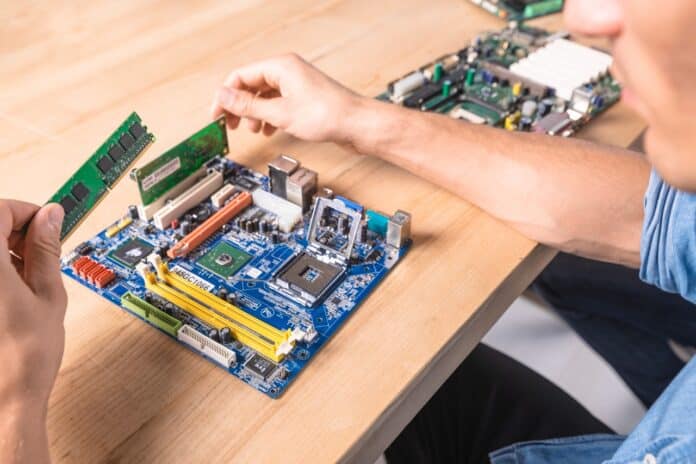Spin-orbit torques (SOTs) generated by topological materials and heavy metals interfaced with ferromagnets can be used in next-generation magnetic memory and logic systems.
When the magnetization and spin are collinear, SOTs produced from y spin arising from Hall and Edelstein effects can achieve field-free magnetization switching.
The demand of more complex artificial intelligence (AI) technologies has caused a significant rise in the demand for processing power during the past ten years. This demand might be met with the help of new, energy-saving hardware designs that offer quicker processing, lower the energy consumption of computing, and allow AI training on the device itself.
Shan Wang, the Leland T. Edwards Professor in the School of Engineering at Stanford University, recently discovered a material that could bring the commercialization of a new type of memory.
He said, “In my opinion, we have already transitioned from the internet era to the AI era. We want to enable AI on edge – training locally on your home computer, phone, or smartwatch – for things like heart attack detection or speech recognition. To do that, you need a high-speed, non-volatile memory.”
The researchers showed that a thin layer of a metallic substance called magnesium palladium three has the characteristics required to support a type of working memory that stores information in electron spin directions.
This memory storage technique, known as spin-orbit torque magnetoresistive random access memory (SOT-MRAM), can store information more quickly and effectively than existing techniques, which use electric charge and require a constant power supply to preserve that information. SOT-MRAM relies on the intrinsic spin feature of electrons to utilize electron spin.
For example, Imagine an electron as a revolving basketball positioned on the end of a professional athlete’s finger to understand spin—the north-south poles of the magnet switch when the electron switches spin directions.
Researchers can use the magnetism’s up or down direction to represent the ones. It zeroes that make up bits and bytes of computer data.
A current running through one material (the SOT layer) in SOT-MRAM generates unique spin directions. The movement of those electrons, combined with their spin directions, produces a torque capable of switching the spin directions and associated magnetic dipole moments of electrons in an adjacent magnetic material. Storing magnetic data with suitable materials is as simple as changing the direction of an electrical current in the SOT layer.
However, locating the appropriate SOT materials takes a lot of work. Data can be stored more densely when electron spin directions are oriented up or down in the z-direction due to how the hardware is structured. (If you picture a sandwich on a plate, the z-direction is the toothpick stuck through the center, and the x- and y-directions follow the sides of the bread.) Most materials, however, polarise electron spins in the y-direction when the current runs in the x-direction.
Fen Xue, a postdoctoral researcher in Wang’s lab, said, “Conventional materials only generate spin in the y-direction – that means we would need an external magnetic field to make switching happen in the z-direction, which takes more energy and space. To lower the energy and have a higher density of memory, we want to be able to realize this switching without an external magnetic field.”
The researchers discovered that magnesium palladium three has the necessary characteristics to create spins in any orientation. Because its internal structure lacks the crystal symmetry that would force all the electrons into a specific orientation, the material can generate spins in any direction.
The researchers used magnesium palladium three to demonstrate magnetization switching in both the y and z directions without using an external magnetic field. However, in the absence of an external magnetic field, x-direction magnetization can be switched.
Mahendra DC, who conducted the work as a postdoctoral researcher at Stanford and is the first author on the paper, said, “We have the same input current as other conventional materials, but we have three different directions of spins now,” “Depending on the application, we can control the magnetization in whatever direction we want.”
He said, “Evgeny Tsymbal’s lab at the University of Nebraska led the calculations to predict the unexpected spin directions and movement, and Julie Borchers’s lab at the National Institute of Standards and Technology led the measurements and modeling efforts to reveal the intricate microstructures within magnesium palladium three, It truly takes a village. Post-annealing requires electronics to be at 400 degrees Celsius for 30 minutes.”
DC said, “That’s one of the challenges for new materials in these devices, and magnesium palladium three can handle that.”
The material has various features that make it a great option for SOT-MRAM applications, including the ability to survive and keep its properties during the post-annealing and magnetron sputtering processes. Furthermore, the layer of magnesium palladium three is generated via magnetron sputtering, a technology previously used in other components of memory-storage hardware.
Xue says, “No new tools or new techniques are needed for this material. We don’t need a textured substrate or special conditions to deposit it.”
As a result, they have a material with innovative features that may help meet our expanding computer needs and fit smoothly into current manufacturing procedures.
The team is already working on SOT-MRAM prototypes made of magnesium palladium three that will be integrated into real-world devices.
The researcher said, “We are hitting a wall with the current technology, So we have to figure out what other options we have.”
This study was funded by Semiconductor Research Corporation (SRC).
Journal Reference:
- DC, M., Shao, D., Hou, V. D., Vailionis, et al. Observation of anti-dumping spin–orbit torques generated by in-plane and out-of-plane spin polarizations in MnPd3. Nature Materials. DOI: 10.1038/s41563-023-01522-3
